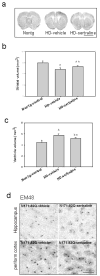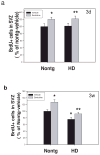Sertraline slows disease progression and increases neurogenesis in N171-82Q mouse model of Huntington's disease
- PMID: 18403212
- PMCID: PMC3683653
- DOI: 10.1016/j.nbd.2008.01.015
Sertraline slows disease progression and increases neurogenesis in N171-82Q mouse model of Huntington's disease
Abstract
Huntington's disease (HD) is an inherited progressive neurodegenerative disorder resulting from CAG repeat expansion in the gene that encodes for the protein huntingtin. To identify neuroprotective compound (s) that can slow down disease progression and can be administered long term with few side effects in Huntington's disease, we investigated the effect of sertraline, a selective serotonin reuptake inhibitor (SSRI) which has been shown to upregulate BDNF levels in rodent brains. We report here that in HD mice sertraline increased BDNF levels, preserved chaperone protein HSP70 and Bcl-2 levels in brains, attenuated the progression of brain atrophy and behavioral abnormalities and thereby increased survival. Sertraline also enhanced neurogenesis, which appeared to be responsible for mediating the beneficial effects of sertraline in HD mice. Additionally, the effective levels of sertraline are comparable to the safe levels achievable in humans. The findings suggest that sertraline is a potential candidate for treatment of HD patients.
Figures







Similar articles
-
The antidepressant sertraline improves the phenotype, promotes neurogenesis and increases BDNF levels in the R6/2 Huntington's disease mouse model.Exp Neurol. 2008 Mar;210(1):154-63. doi: 10.1016/j.expneurol.2007.10.015. Epub 2007 Nov 9. Exp Neurol. 2008. PMID: 18096160 Free PMC article.
-
Tiagabine is neuroprotective in the N171-82Q and R6/2 mouse models of Huntington's disease.Neurobiol Dis. 2008 Jun;30(3):293-302. doi: 10.1016/j.nbd.2008.01.014. Epub 2008 Mar 10. Neurobiol Dis. 2008. PMID: 18395459 Free PMC article.
-
Neuroprotective effects of PPAR-γ agonist rosiglitazone in N171-82Q mouse model of Huntington's disease.J Neurochem. 2013 May;125(3):410-9. doi: 10.1111/jnc.12190. Epub 2013 Mar 5. J Neurochem. 2013. PMID: 23373812 Free PMC article.
-
Neuroprotective effects of psychotropic drugs in Huntington's disease.Int J Mol Sci. 2013 Nov 15;14(11):22558-603. doi: 10.3390/ijms141122558. Int J Mol Sci. 2013. PMID: 24248060 Free PMC article. Review.
-
Mouse models of Huntington's disease.Trends Pharmacol Sci. 2002 Jan;23(1):32-9. doi: 10.1016/s0165-6147(00)01884-8. Trends Pharmacol Sci. 2002. PMID: 11804649 Review.
Cited by
-
Extensive changes in DNA methylation are associated with expression of mutant huntingtin.Proc Natl Acad Sci U S A. 2013 Feb 5;110(6):2354-9. doi: 10.1073/pnas.1221292110. Epub 2013 Jan 22. Proc Natl Acad Sci U S A. 2013. PMID: 23341638 Free PMC article.
-
Appropriate Scaffold Selection for CNS Tissue Engineering.Avicenna J Med Biotechnol. 2020 Oct-Dec;12(4):203-220. Avicenna J Med Biotechnol. 2020. PMID: 33014312 Free PMC article. Review.
-
Adult neural progenitor cells from Huntington's disease mouse brain exhibit increased proliferation and migration due to enhanced calcium and ROS signals.Cell Prolif. 2015 Oct;48(5):517-31. doi: 10.1111/cpr.12205. Epub 2015 Aug 13. Cell Prolif. 2015. PMID: 26269226 Free PMC article.
-
Preclinical Evidence Supporting Early Initiation of Citalopram Treatment in Machado-Joseph Disease.Mol Neurobiol. 2019 May;56(5):3626-3637. doi: 10.1007/s12035-018-1332-1. Epub 2018 Sep 1. Mol Neurobiol. 2019. PMID: 30173407
-
Efficacy of sertraline against Trypanosoma cruzi: an in vitro and in silico study.J Venom Anim Toxins Incl Trop Dis. 2018 Oct 30;24:30. doi: 10.1186/s40409-018-0165-8. eCollection 2018. J Venom Anim Toxins Incl Trop Dis. 2018. PMID: 30450114 Free PMC article.
References
-
- Bates G. Huntingtin aggregation and toxicity in Huntington’s disease. Lancet. 2003;361(9369):1642–4. - PubMed
-
- Beal MF, Walker LC, Storey E, Segar L, Price DL, Cork LC. Kynurenine pathway measurements in Huntington’s disease striatum: evidence for reduced formation of kynurenic acid. J Neurochem. 1990;55(4):1327–39. - PubMed
-
- Bemelmans AP, Horellou P, Pradier L, Brunet I, Colin P, Mallet J. Brain-derived neurotrophic factor-mediated protection of striatal neurons in an excitotoxic rat model of Huntington’s disease, as demonstrated by adenoviral gene transfer. Hum Gene Ther. 1999;10(18):2987–97. - PubMed
-
- Bodner RA, Housman DE, Kazantsev AG. New directions for neurodegenerative disease therapy: using chemical compounds to boost the formation of mutant protein inclusions. Cell Cycle. 2006;5(14):1477–80. - PubMed
Publication types
MeSH terms
Substances
Grants and funding
LinkOut - more resources
Full Text Sources
Other Literature Sources
Medical

